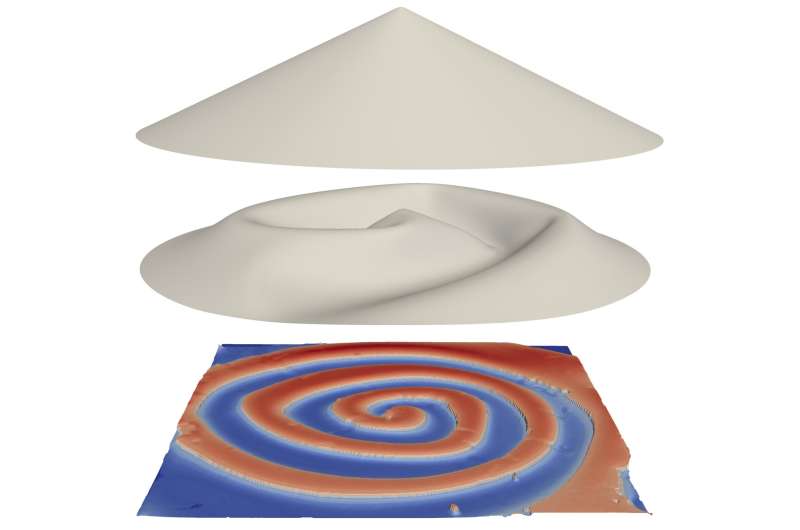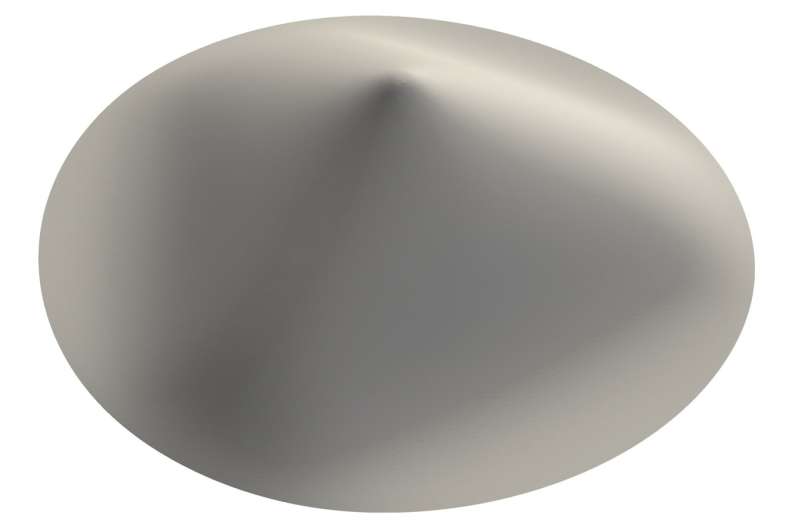October 25, 2023 feature
This article has been reviewed according to Science X's editorial process and policies. Editors have highlighted the following attributes while ensuring the content's credibility:
fact-checked
peer-reviewed publication
trusted source
proofread
A new formula to calculate the strength of thin conical structures

Conical structures can have advantageous applications in a variety of fields, ranging from robotics to civil engineering. Studies have found that conical shells made of liquid crystal elastomer films can be effective lifters; devices that can generate thrust for robots and other vehicles.
Researchers at University of Cambridge and University of Colorado Boulder (UC Boulder) recently carried out a study assessing the load-bearing capacity and robustness of conical shells. Their paper, published in Physical Review Letters, shows that thin conical structures are surprisingly weak, while also introducing a new numerical formula for the critical buckling load.
"Our paper came about because we were studying thin sheets that morph from flat into new shapes," Daniel Duffy, principal investigator for the study, told Phys.org.
"An inspiring now-classic example, due to our co-author Timothy White and his group, is a soft flat sheet that morphs into a cone upon heating, lifting thousands of times its own weight in the process. We wanted to understand how to optimize this already-spectacular performance, so we began by just asking 'how much weight can a cone support?', and discovered that, surprisingly, the correct answer was not in the literature."
The primary objective of the recent work by Duffy and his colleagues was to reliably determine how much weight a given conical structure can support. Their results were somewhat surprising, showing that the critical load that cones can bear greatly depends on their thickness.
"To examine the load-bearing capacity of conical shells, we used a whole range of techniques," Duffy explained. "On the experimental side, our collaborators in Timothy White's group at UC Boulder fabricated thin cones and balanced very small known weights on top of them, incrementally increasing the weight until the cones buckled. We then compared those results with careful full 3D simulations of a matching setup."
Based on their experimental and numerical results, the researchers devised a mathematical, "boundary-layer" theory to describe the edge of a cone, which proved to be closely connected to a cone's strength. They then carried out further numerical calculations to test the ability of this boundary-layer theory to reproduce experimental results and their 3D simulations.
"Some more mathematical simplifications led to an even simpler theory in the case of an extremely thin cone, after which yet-simpler numerical calculations finally produced our new formula for the strength of a cone. Overall, asymptotic boundary-layer analysis was the key mathematical tool; informally, 'zooming in' on the boundary allows us to make many mathematical simplifications."
Overall, the experiments and simulations carried out by Duffy and his colleagues suggest that thin cones with free (i.e., unclamped) boundaries are surprisingly weak. In fact, the team found that the thinner a cone is, the greater the disagreement with theoretical predictions previously put forward by physicists and engineers.

"Our new formula for cone strength depends on the cone's thickness in a whole new way, which was a real surprise," Duffy said.
"In jargon, our formula 'has a new thickness scaling.' Furthermore, many previous works found thin structures to be 'surprisingly' weak, but the only precise understanding of this has been based on the influence of imperfections. In contrast, our results are for perfect cones, so we have discovered a whole new kind of way that thin structures can be surprisingly weak; a new paradigm of weakening, if you like."
Accurately predicting the strength of conical structures could be highly valuable for both physicists and engineers who are trying to determine how these structures will behave in specific situations. Duffy and his colleagues were particularly interested in calculating the strength of conical shells for soft robotics applications, yet in the future their formula could be applied to a broad range of other items, ranging from satellites to kitchenware.
"Our two main plans for future research in this area include leveraging our results to address our original question of 'how can we optimize soft shape-morphing cones to lift the biggest weights?'," Duffy added. "In addition, we plan to further explore the mechanics of the intricate curved ridges our buckled cones developed, which have rich and intriguing behaviors, and may have potential in new soft-robotic devices."
More information: Daniel Duffy et al, Lifting, Loading, and Buckling in Conical Shells, Physical Review Letters (2023). DOI: 10.1103/PhysRevLett.131.148202
Journal information: Physical Review Letters
© 2023 Science X Network




















